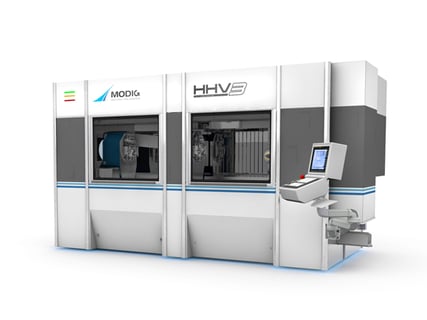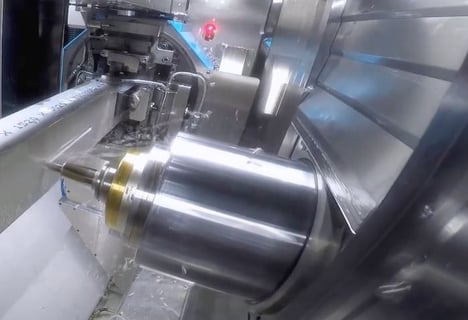Compared to conventional machining, the Modig way of bar machining demonstrated reduced set up-time, no work holding, and a significant reduction in cycle time. To explain the differences between the processes in the best way, we will use a case study from real life. An aerospace part, a Link, for commercial aircraft first produced with conventional machining and then by the Modig way. How much time could you save by machining this aerospace part for commercial aircraft from uncut bars in the HHV, a universal machining center from Modig?
The old conventional machining process
When describing old conventional processing, we have a process in mind following these five main manufacturing steps from the uncut bar to the finished part.
1. Cut raw material to the correct length.
Before the raw material is loaded into the machine, the bar must be pre-cut into the correct length in another device capable of cutting metal bars.
2. Clamp material in the machine.
When the raw material is cut to the desired length, it is time to clamp the material in the machine. The clamping procedure must be exact to meet the tolerances of the finished part.

3. Machining of available sides.
Old conventional machining occurs mainly in a 3-axis machine where the workpiece is fixed in one position, and the spindle can move back and forth to the left and right and up and down when machining available sides. 3-axis machining is suitable for parts that don’t require much detail and depth.
4. Machining stops – the operator turns the part and clamps it again.
When this aerospace part for commercial aircraft is machined in a 3-axis machine, the operator must stop the machine several times to remove the workpiece from the machine, turn it, redirect and re-clamp it again before cutting on the remaining sides. A time-consuming procedure that also can interfere with the quality of the part. Every time the workpiece has to be adjusted during machining, there is a significant risk of reduced accuracy. The slightest error in positioning the workpiece can devastate the finished part.
5. Place new material and repeat the procedure.
Approximately 97 min later, the Link is manufactured, and it is time to place new material and repeat the process.
The Modig way
Bar machining in the horizontal machining center HHV is described in Modig’s own words as intelligent bar machining with automation excellence. Following the process, it is hard not to agree because the HHV opens up for 4- and even 5-axis machining with high production rate capabilities.
HHV feeds the raw material
The HHV can machine bars that are 5 x 5” (127 x 127 mm) in unlimited length with an option for larger bars. The raw material doesn´t need to be pre-cut to a specific size. The HHV automatically feeds uncut bars of unlimited length and machines multiple parts from the same block, which usually reduces raw material use.
Machining of bar stock material
One of the HHV´s superpowers is the ability to complete parts in one setup, with no work holding, in contrast to standard machines that often require multiple setups. While the operator, during old conventional machining, has to stop the machine several times to turn or adjust the workpiece to allow machining on more sides. The HHV automatically rotates the bar and gives the spindle access to all sides of the workpiece. It drastically reduces the machining time and the finished part’s quality.
Reduced cycle time
It took 97 minutes to produce this aerospace part for commercial aircraft with conventional machining. Modig says the machining time is approximately 50-70% less than conventional. Will the Link case study succeed and prove Modig´s claim, or will it go down in flames?
For the HHV, it takes 23 minutes to machine the uncut bar to a Link for commercial aircraft. This means a significant cycle time reduction, with time savings of 74 minutes and a time reduction of 76%.

Automation options
Automation excellence is mentioned above, and to live up to that, HHV can be combined with optional automatic loading and unloading system or a complete production cell for workpiece handling.
Learn more about HHV and discover if the HHV will suit your business and boost your productivity.




